Assisted Tip Sonication Approach for Graphene Synthesis in Aqueous Dispersion
Abstract
1. Introduction
2. Experimental Section
2.1. Materials
2.2. Techniques
2.3. Synthesis of Reduced Graphene Oxide (RGO)
2.4. Synthesis of Dispersed Graphene Nanoplatelets (DGP)
3. Results and Discussion
3.1. Elemental Analysis
3.2. Raman Spectra
3.3. Infrared and Ultra-violet Spectroscopy
3.4. X-ray Diffraction
3.5. Transmission Electron Microscope (TEM)
3.6. Scanning Electron Microscope (SEM)
3.7. Atomic Force Microscope (AFM)
3.8. Electrochemical Measurements
3.8.1. Cyclic Voltammetry
3.8.2. Concentration/Conductivity Relationship
3.9. Electrical Conductivity Measurements
4. Conclusions
Author Contributions
Acknowledgments
Conflicts of Interest
References
- Novoselov, K.S.; Geim, A.K.; Morozov, S.V.; Jiang, D.; Zhang, Y.; Dubonos, S.V.; Grigorieva, I.V.; Firsov, A.A. Electric field effect in atomically thin carbon films. Science 2004, 306, 666–669. [Google Scholar] [CrossRef] [PubMed]
- Balandin, A.; Ghosh, S.; Bao, W.; Calizo, I.; Teweldebrhan, D.; Miao, F.; Lau, C.N. Superior Thermal Conductivity of Single-Layer Graphene. Nano Lett. 2008, 8, 902–907. [Google Scholar] [CrossRef] [PubMed]
- Bolotin, K.; Sikes, K.J.; Jiang, Z.; Klima, M.; Fudenberg, G.; Hone, J.; Kim, P.; Stormer, H.L. Ultrahigh electron mobility in suspended graphene. Solid State Commun. 2008, 146, 351–355. [Google Scholar] [CrossRef]
- Lee, C.; Wei, X.; Kysar, J.; Hone, J. Measurement of the elastic properties and intrinsic strength of monolayer graphene. Science 2008, 321, 385–388. [Google Scholar] [CrossRef] [PubMed]
- Stoller, M.D.; Park, S.; Zhu, Y.; An, J.; Ruoff, R.S. Graphene-Based Ultracapacitors. Nano Lett. 2008, 8, 3498–3502. [Google Scholar] [CrossRef] [PubMed]
- Chae, H.K.; Siberio-Perez, D.Y.; Kim, J.; Go, Y.; Eddaoudi, M.; Matzger, A.J.; O’Keeffe, M.; Yaghi, O.M. A route to high surface area; porosity and inclusion of large molecules in crystals. Nature 2004, 427, 523–527. [Google Scholar] [CrossRef] [PubMed]
- Kang, X.; Wang, J.; Wu, H.; Liu, J.; Aksay, I.A.; Lin, Y.A. A graphene-based electrochemical sensor for sensitive detection of paracetamol. Talanta 2010, 81, 754–759. [Google Scholar] [CrossRef] [PubMed]
- Patchkovskii, S.; Tse, J.S.; Yurchenko, S.N.; Zhechkov, L.; Heine, T.; Seifert, G. Graphene nanostructures as tunable storage media for molecular hydrogen. Proc. Natl. Acad. Sci. USA 2005, 102, 10439–10444. [Google Scholar] [CrossRef] [PubMed]
- Schedin, F.; Geim, A.K.; Morozov, S.V.; Hill, E.W.; Blake, P.; Katsnelson, M.I.; Novoselov, K.S. Detection of individual gas molecules adsorbed on graphene. Nat. Mater. 2007, 6, 652–655. [Google Scholar] [CrossRef] [PubMed]
- Dua, V.; Surwade, S.P.; Ammu, S.; Agnihotra, S.R.; Jain, S.; Roberts, K.E.; Park, S.; Ruoff, R.S.; Manohar, S.K. All-organic vapor sensor using inkjet-printed reduced graphene oxide. Angew. Chem. Int. Ed. 2010, 49, 2154–2157. [Google Scholar] [CrossRef] [PubMed]
- Avouris, P.; Chen, Z.H.; Perebeinos, V. Carbon-based electronics. Nat. Nanotechnol. 2007, 2, 605–615. [Google Scholar] [CrossRef] [PubMed]
- Eda, G.; Chhowalla, M. Graphene-based Composite Thin Films for Electronics. Nano Lett. 2009, 9, 814–818. [Google Scholar] [CrossRef] [PubMed]
- Ramanathan, T.; Abdala, A.; Stankovich, S.; Dikin, D.; Herrera-Alonso, M.; Piner, R.D.; Adamson, D.H.; Schniepp, H.C.; Chen, X.; Ruoff, R.S.; et al. Functionalized graphene sheets for polymer nanocomposites. Nat. Nanotechnol. 2008, 3, 327–331. [Google Scholar] [CrossRef] [PubMed]
- Scheuermann, G.; Rumi, L.; Steurer, P.; Bannwarth, W.; Mülhaupt, R. Palladium Nanoparticles on Graphite Oxide and Its Functionalized Graphene Derivatives as Highly Active Catalysts for the Suzuki−Miyaura Coupling Reaction. J. Am. Chem. Soc. 2009, 131, 8262–8270. [Google Scholar] [CrossRef] [PubMed]
- Wang, X.; Zhi, L.; Müllen, K. Transparent; Conductive Graphene Electrodes for Dye-Sensitized Solar Cells. Nano Lett. 2008, 8, 323–327. [Google Scholar] [CrossRef] [PubMed]
- Wu, J.; Agrawal, M.; Becerril, H.A.; Bao, Z.N.; Liu, Z.; Chen, Y.; Peumans, P. Organic Light-Emitting Diodes on Solution-Processed Graphene Transparent Electrodes. ACS Nano 2010, 4, 43–48. [Google Scholar] [CrossRef] [PubMed]
- Echtermeyer, T.; Britnell, L.; Jasnos, P.; Lombardo, A.; Gorbachev, R.V.; Grigorenko, A.N.; Geim, A.K.; Ferrari, A.C.; Novoselov, K.S. Strong plasmonic enhancement of photovoltage in graphene. Nat. Commun. 2011, 2, 458–462. [Google Scholar] [CrossRef] [PubMed]
- Konstantatos, G.; Badioli, M.; Gaudreau, L.; Osmond, J.; Bernechea, M.; de Arquer, F.P.G.; Gatti, F.; Koppens, F.H.L. Hybrid graphene-quantum dot phototransistors with ultrahigh gain. Nat. Nanotechnol. 2012, 7, 363–368. [Google Scholar] [CrossRef] [PubMed]
- Bae, S.; Kim, H.; Lee, Y.; Xu, X.; Park, J.; Zheng, Y.; Balakrishnan, J.; Lei, T.; Ri Kim, H.; Song, Y.I.; et al. Roll-to-roll production of 30-inch graphene films for transparent electrodes. Nat. Nanotechnol. 2010, 5, 574–578. [Google Scholar] [CrossRef] [PubMed]
- Kim, K.; Zhao, Y.; Jang, H.; Lee, S.; Kim, J.; Kim, K.S.; Ahn, J.-H.; Kim, P.; Choi, J.-Y.; Hong, B.H. Large-scale pattern growth of graphene films for stretchable transparent electrodes. Nature 2009, 457, 706–710. [Google Scholar] [CrossRef] [PubMed]
- Chen, L.; Hernandez, Y.; Feng, X.; Müllen, K. From nanographene and graphene nanoribbons to graphene sheets: Chemical synthesis. Angew. Chem. Int. Ed. 2012, 51, 7640–7654. [Google Scholar] [CrossRef] [PubMed]
- León, V.; Quintana, M.; Herrero, M.A.; Fierro, J.; de la Hoz, A.; Prato, M.; Vázquez, E. Few-layer graphenes from ball-milling of graphite with melamine. Chem. Commun. 2011, 47, 10936–10938. [Google Scholar] [CrossRef] [PubMed]
- Novoselov, K.; Jiang, D.; Schedin, F.; Booth, T.; Khotkevich, V.; Morozov, S.; Geim, A. Two-dimensional atomic crystals. Proc. Natl. Acad. Sci. USA 2005, 102, 10451–10453. [Google Scholar] [CrossRef] [PubMed]
- Jiang, H. Chemical preparation of graphene-based nanomaterials and their applications in chemical and biological sensors. Small 2011, 7, 2413–2427. [Google Scholar] [CrossRef] [PubMed]
- Rao, C.; Subrahmanyam, K.S.; Ramakrishna Matte, H.; Maitra, U.; Moses, K.; Govindaraj, A. Graphene: Synthesis; functionalization and properties. Inter. J. Modern Phys. B 2011, 25, 4107–4143. [Google Scholar] [CrossRef]
- Coleman, J. Liquid Exfoliation of Defect-Free Graphene. Acc. Chem. Res. 2013, 46, 14–22. [Google Scholar] [CrossRef] [PubMed]
- Ciesielski, A.; Samor, P. Graphene via sonication assisted liquid-phase exfoliation. Chem. Soc. Rev. 2014, 43, 381–398. [Google Scholar] [CrossRef] [PubMed]
- An, X.; Simmons, T.; Shah, R.; Wolfe, C.; Lewis, K.M.; Washington, M.; Nayak, S.K.; Talapatra, S.; Kar, S. Stable aqueous dispersions of noncovalently functionalized graphene from graphite and their multifunctional high-performance applications. Nano Lett. 2010, 10, 4295–4301. [Google Scholar] [CrossRef] [PubMed]
- Sahoo, S.; Hatui, G.; Bhattacharya, P.; Dhibar, S.; Das, C.K. One Pot Synthesis of Graphene by Exfoliation of Graphite in ODCB. Graphene 2013, 2, 42–48. [Google Scholar] [CrossRef]
- Yang, W.; Widenkvist, E.; Jansson, U.; Grennber, H. Stirring-induced aggregation of graphene in suspension. New J. Chem. 2011, 35, 780–783. [Google Scholar] [CrossRef]
- Bourlinos, A.; Georgakilas, V.; Zboril, R.; Steriotis, T.A.; Stubos, A.K. Liquid-phase exfoliation of graphite towards solubilized graphenes. Small 2009, 5, 1841–1845. [Google Scholar] [CrossRef] [PubMed]
- Hamilton, C.E.; Lomeda, J.R.; Sun, Z.Z.; Tour, J.; Barron, A. High-yield organic dispersions of unfunctionalized graphene. Nano Lett. 2009, 9, 3460–3462. [Google Scholar] [CrossRef] [PubMed]
- Zhang, X.; Coleman, A.; Katsoni, N.; Browne, W.; van Wees, B.; Feringa, B. Dispersion of graphene in ethanol using a simple solvent exchange method. Chem. Commun. 2010, 46, 7539–7541. [Google Scholar] [CrossRef] [PubMed]
- Nuvoli, D.; Valentini, L.; Alzari, V.; Scognamillo, S.; Bon, S.; Piccinini, M.; Illescas, J.; Mariani, A. High concentration few layer graphene sheets obtained by liquid phase exfoliation of graphite in ionic liquid. J. Mater. Chem. 2011, 21, 3428–3431. [Google Scholar] [CrossRef]
- O’Neill, A.; Khan, U.; Nirmalraj, P.; Boland, J.; Coleman, J. Graphene Dispersion and Exfoliation in Low Boiling Point Solvents. J. Phys. Chem. C 2011, 115, 5422–5428. [Google Scholar] [CrossRef]
- Israelachvili, J. Intermolecular and Surface Forces, 3rd ed.; Elsevier: San Diego, CA, USA, 2011; pp. 326–334. ISBN 978-0-12-391927-4. [Google Scholar]
- Lotya, M.; King, P.; Khan, U.; De, S.; Coleman, J. High-Concentration; Surfactant-Stabilized Graphene Dispersions. ACS Nano 2010, 4, 3155–3162. [Google Scholar] [CrossRef] [PubMed]
- Skaltsas, T.; Karousis, N.; Yan, H.; Wang, C.; Pispas, S.; Tagmatarchis, N. Graphene exfoliation in organic solvents and switching solubility in aqueous media with the aid of amphiphilic block copolymers. J. Mater. Chem. 2012, 22, 21507–21512. [Google Scholar] [CrossRef]
- Zhang, H.; Wen, J.; Meng, X.; Yao, Y.; Yin, G.F.; Liao, X.; Huang, Z.B. An Improved Method to Increase the Concentration of Graphene in Organic Solvent. Chem. Lett. 2012, 41, 747–749. [Google Scholar] [CrossRef]
- Noroozi, M.; Zakaria, A.; Radiman, S.; Abdul Waha, Z. Environmental Synthesis of Few Layers Graphene Sheets Using Ultrasonic Exfoliation with Enhanced Electrical and Thermal Properties. PLoS ONE 2016, 11, 1–17. [Google Scholar] [CrossRef] [PubMed]
- Takayanagi, T.; Morimoto, M.; Yabutani, T. Micellar electrokinetic chromatography of graphene and chemically modified graphenes with dodecylbenzenesulfonate. Anal. Sci. 2013, 29, 769–771. [Google Scholar] [CrossRef][Green Version]
- Song, Y.; Lee, H.; Ko, J.; Ryu, J.; Kim, M.; Sohn, D. Preparation and Characterization of Surfactant-Exfoliated Graphene. Bull. Korean Chem. Soc. 2014, 35, 2009–2012. [Google Scholar] [CrossRef][Green Version]
- Lotya, M.; Hernandez, Y.; King, P.; Smith, R.; Nicolosi, V.; Karlsson, L.; Blighe, F.M.; De, S.; Wang, Z.; McGovern, I.T.; et al. Liquid phase production of graphene by exfoliation of graphite in surfactant/water solutions. J. Am. Chem. Soc. 2009, 131, 3611–3620. [Google Scholar] [CrossRef] [PubMed]
- Sukumaran, S.; Jinesh, K.; Gopchandran, K. Liquid phase exfoliated graphene for electronic applications. Mater. Res. Express 2017, 4, 1–19. [Google Scholar] [CrossRef]
- Yoon, G.; Seo, D.; Ku, K.; Kim, J.; Jeon, S.; Kang, K. Factors Affecting the Exfoliation of Graphite Intercalation Compounds for Graphene Synthesis. Chem. Mater. 2015, 27, 2067–2073. [Google Scholar] [CrossRef]
- Schmaltz, B.; Weil, T.; Müllen, K. Polyphenylene-based materials: Control of the electronic function by molecular and supramolecular complexity. Adv. Mater. 2009, 21, 1067–1078. [Google Scholar] [CrossRef]
- De, S.; King, P.; Lotya, M.; O’Neill, A.; Doherty, E.; Hernandez, Y.; Duesberg, G.; Coleman, J. Flexible; transparent; conducting films of randomly stacked graphene from surfactant stabilized; oxide-free graphene dispersions. Small 2010, 6, 458–464. [Google Scholar] [CrossRef] [PubMed]
- Yeon, C.; Yun, S.; Lee, K.; Lim, J. High-yield graphene exfoliation using sodium dodecyl sulfate accompanied by alcohols as surface-tension-reducing agents in aqueous solution. Carbon 2015, 83, 136–143. [Google Scholar] [CrossRef]
- Bourlinos, A.; Georgakilas, V.; Zboril, R.; Steriotis, T.; Stubos, A.; Trapalis, C. Organic functionalisation of graphenes. Solid State Commun. 2009, 149, 2172–2176. [Google Scholar] [CrossRef]
- Guardia, L.; Fernandez-Merino, M.; Paredes, J.; Solis-Fernandez, P.; Villar-Rodil, S.; Martinez-Alonso, A.; Tascon, J. High-throughput production of pristine graphene in an aqueous dispersion assisted by non-ionic surfactants. Carbon 2011, 49, 1653–1662. [Google Scholar] [CrossRef]
- Liang, Y.; Hersam, M. Highly Concentrated Graphene Solutions via Polymer Enhanced Solvent Exfoliation and Iterative Solvent Exchange. J. Am. Chem. Soc. 2010, 132, 17661–17663. [Google Scholar] [CrossRef] [PubMed]
- Lockwood, N.; de Pablo, J.; Abbott, N. Influence of Surfactant Tail Branching and Organization on the Orientation of Liquid Crystals at Aqueous−Liquid Crystal Interfaces. Langmuir 2005, 21, 6805–6814. [Google Scholar] [CrossRef] [PubMed]
- Nicolosi, V.; Chhowalla, M.; Kanatzidis, M.; Strano, M.; Coleman, J. Liquid exfoliation of layered materials. Science 2013, 340, 1226419–1226437. [Google Scholar] [CrossRef]
- Jung, I.; Dikin, D.; Piner, R.; Ruoff, R. Tunable electrical conductivity of individual graphene oxide sheets reduced at “low” temperatures. Nano Lett. 2008, 8, 4283–4287. [Google Scholar] [CrossRef] [PubMed]
- Park, S.; An, J.; Jung, I.; Piner, R.; An, S.; Li, X.; Velamakanni, A.; Ruoff, R. Colloidal suspensions of highly reduced graphene oxide in a wide variety of organic solvents. Nano Lett. 2009, 9, 1593–1597. [Google Scholar] [CrossRef] [PubMed]
- Mativetsky, J.; Liscio, A.; Treossi, E.; Orgiu, E.; Zanelli, A.; Samor, P.; Palermo, V. Graphene Transistors via in Situ Voltage-Induced Reduction of Graphene-Oxide under Ambient Conditions. J. Am. Chem. Soc. 2011, 133, 14320–14326. [Google Scholar] [CrossRef] [PubMed]
- Tölle, F.; Fabritius, M.; Mülhaupt, R. Emulsifier-free graphene dispersions with high graphene content for printed electronics and freestanding graphene films. Adv. Funct. Mater. 2012, 22, 1136–1144. [Google Scholar] [CrossRef]
- Stankovich, S.; Dikin, D.; Piner, R.; Kohlhaas, K.; Kleinhammes, A.; Jia, Y.; Wu, Y.; Nguyen, S.T.; Ruoff, R.S. Synthesis of graphene-based nanosheets via chemical reduction of exfoliated graphite oxide. Carbon 2007, 45, 1558–1565. [Google Scholar] [CrossRef]
- Zalan, Z.; Lazar, L.; Fueloep, F. Chemistry of hydrazinoalcohols and their heterocyclic derivatives. Part 1. Synthesis of hydrazinoalcohols. Curr. Org. Chem. 2005, 9, 357–376. [Google Scholar] [CrossRef]
- Schniepp, H.; Li, J.; McAllister, M.; Sai, H.; Herrera-Alonso, M.; Adamson, D.; Prud’homme, R.K.; Car, R.; Saville, D.A.; Aksay, I.A. Functionalized single graphene sheets derived from splitting graphite oxide. J. Phys. Chem. B 2006, 110, 8535–8539. [Google Scholar] [CrossRef] [PubMed]
- Mattevi, C.; Eda, G.; Agnoli, S.; Miller, S.; Mkhoyan, K.; Celik, O.; Mastrogiovanni, D.; Granozzi, G.; Garfunkel, E.; Chhowalla, M. Evolution of electrical; chemical; and structural properties of transparent and conducting chemically derived graphene thin films. Adv. Funct. Mater. 2009, 19, 2577–2583. [Google Scholar] [CrossRef]
- Frank, O.; Mohr, M.; Maultzsch, J.; Thomsen, C.; Riaz, I.; Jalil, R.; Novoselov, K.S.; Tsoukleri, G.; Parthenios, J.; Papagelis, K.; et al. Raman 2D-Band Splitting in Graphene: Theory and Experiment. ACS Nano 2011, 5, 2231–2239. [Google Scholar] [CrossRef] [PubMed]
- Abdolhosseinzadeh, S.; Asgharzadeh, H.; Kim, H. Fast and fully-scalable synthesis of reduced graphene oxide. Sci. Rep. 2015, 5, 10160. [Google Scholar] [CrossRef] [PubMed]
- Graf, D.; Molitor, F.; Ensslin, K.; Stampfer, C.; Jungen, A.; Hierold, C.; Wirtz, L. Spatially Resolved Raman Spectroscopy of Single- and Few-Layer Graphene. Nano Lett. 2007, 7, 238–242. [Google Scholar] [CrossRef] [PubMed]
- Dresselhaus, M.; Jorio, A.; Hofmann, M.; Dresselhaus, G.; Saito, R. Perspectives on carbon nanotubes and graphene Raman spectroscopy. Nano Lett. 2010, 10, 751–758. [Google Scholar] [CrossRef] [PubMed]
- Nawaz, K.; Ayub, M.; Khan, M.; Hussain, A.; Malik, A.; Niazi, M.; Hussain, M.; Khan, A.; Ul-Haq, N. Effect of Concentration of Surfactant on the Exfoliation of Graphite to Graphene in Aqueous Media. Nanomater. Nanotechnol. 2016, 6, 1–7. [Google Scholar] [CrossRef]
- Khan, U.; O’Neill, A.; Lotya, M.; De, S.; Coleman, J. High-Concentration Solvent Exfoliation of Graphene. Small 2010, 6, 864–871. [Google Scholar] [CrossRef] [PubMed]
- Li, D.; Muller, M.; Gilje, S.; Kaner, R.; Wallace, G. Processable aqueous dispersions of graphene nanosheets. Nat. Nanotechnol. 2008, 3, 101–105. [Google Scholar] [CrossRef] [PubMed]
- Viana, R.; da Silva, A.; Pimentel, A. Infrared Spectroscopy of Anionic; Cationic; and Zwitterionic Surfactants. Adv. Phys. Chem. 2012, 2012, 1–14. [Google Scholar] [CrossRef]
- Paredes, J.; Villar-Rodil, S.; Martinez-Alonso, A.; Tascon, J. Graphene Oxide Dispersions in Organic Solvents. Langmuir 2008, 24, 10560–10564. [Google Scholar] [CrossRef] [PubMed]
- Kashyap, S.; Mishra, S.; Behera, S.K. Aqueous Colloidal Stability of Graphene Oxide and Chemically Converted Graphene. J. Nanopart. 2014, 2014, 640281. [Google Scholar] [CrossRef]
- Abdelsayed, V.; Moussa, S.; Hassan, H.; Aluri, H.; Collinson, M.; Samy, E.M. Photothermal Deoxygenation of Graphite Oxide with Laser Excitation in Solution and Graphene-Aided Increase in Water Temperature. J. Phys. Chem. Lett. 2010, 1, 2804–2809. [Google Scholar] [CrossRef]
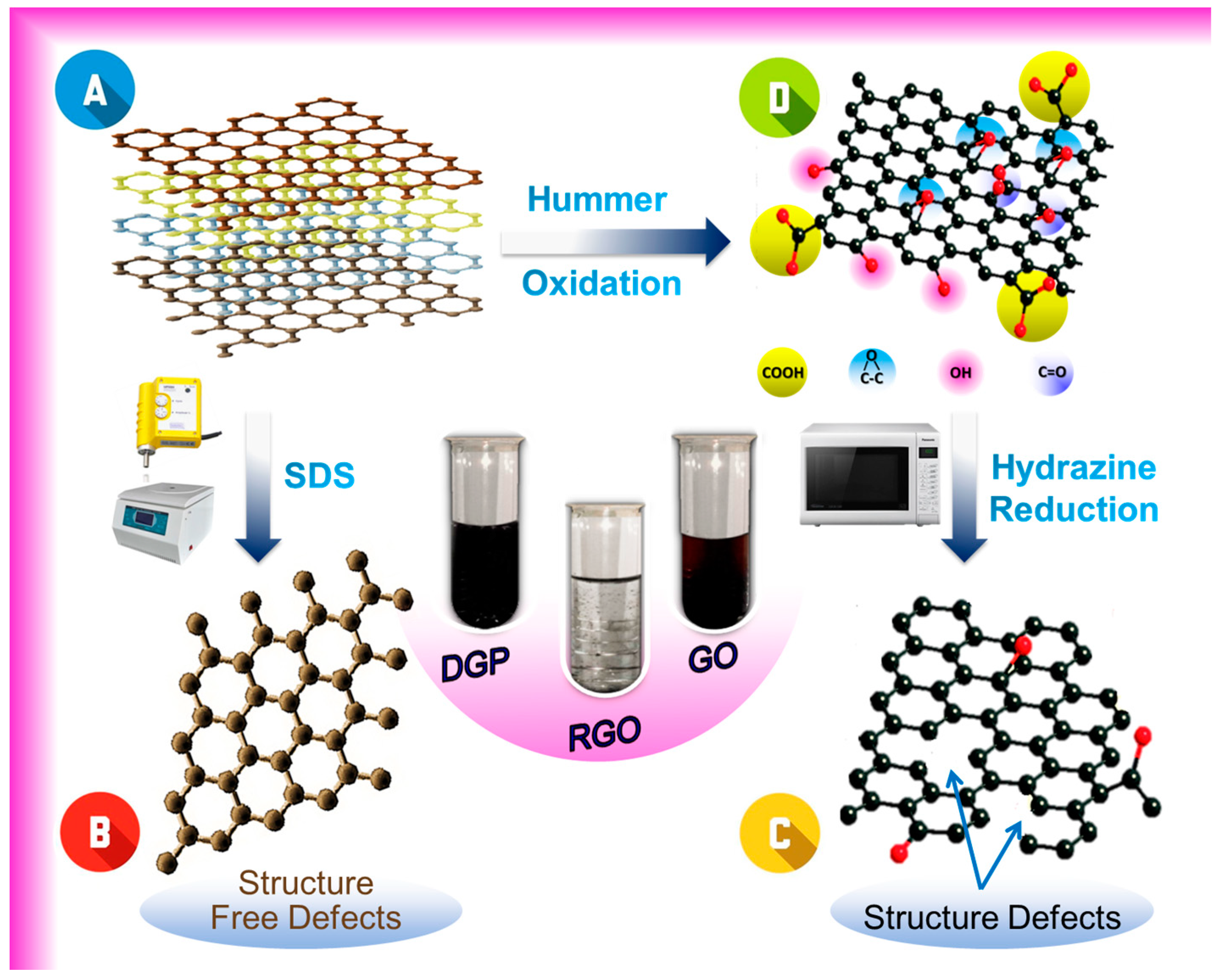
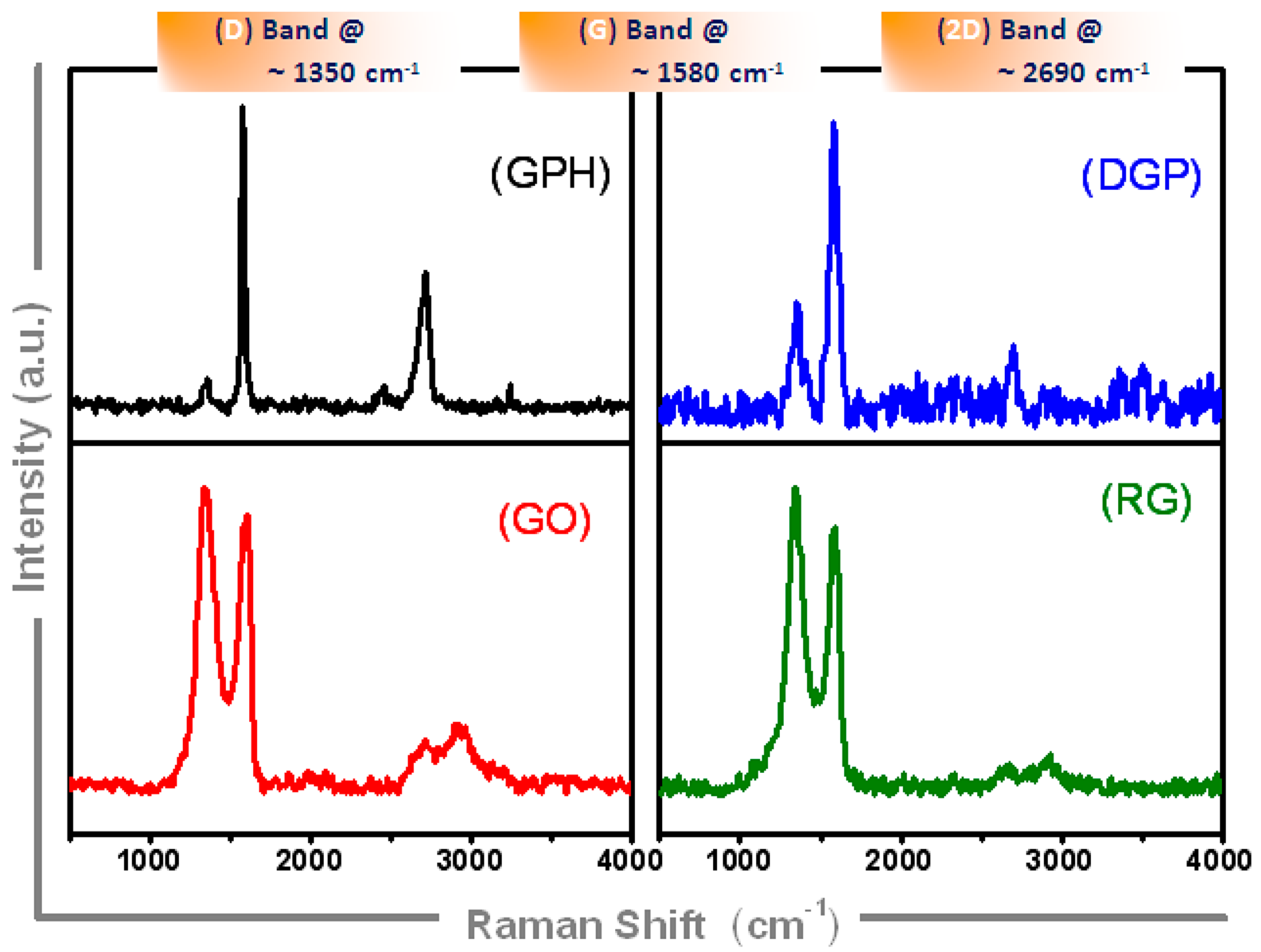
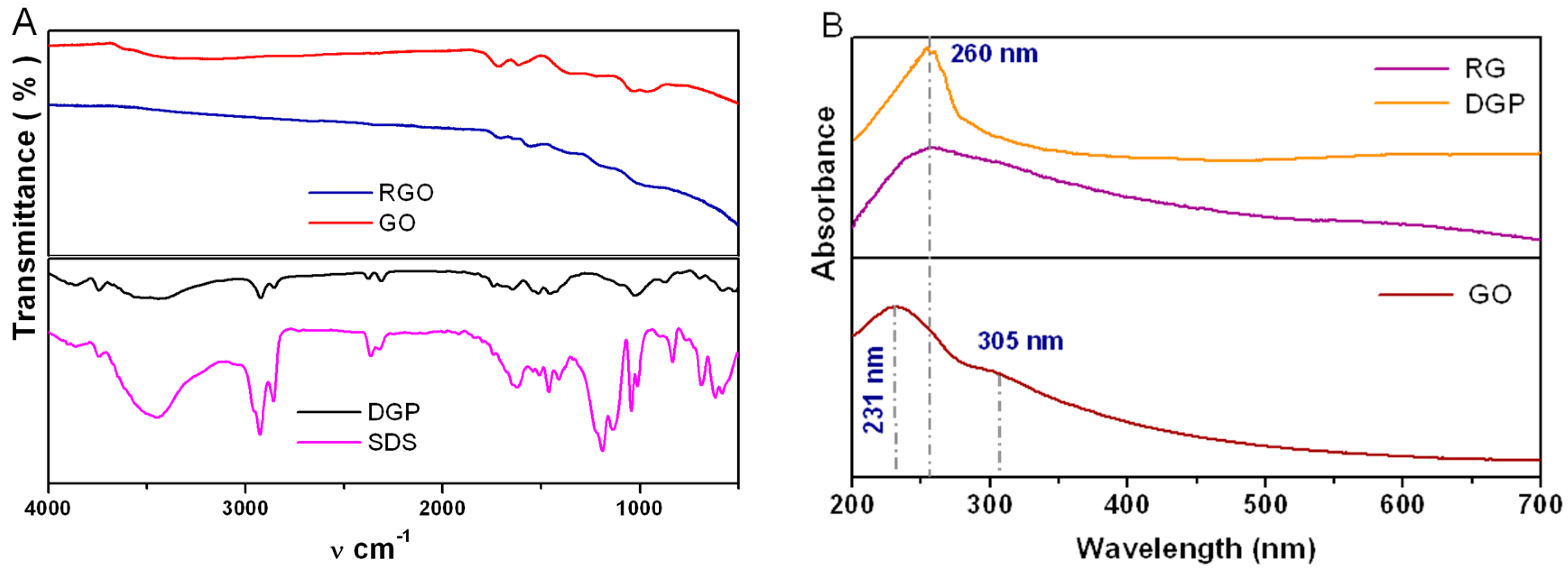
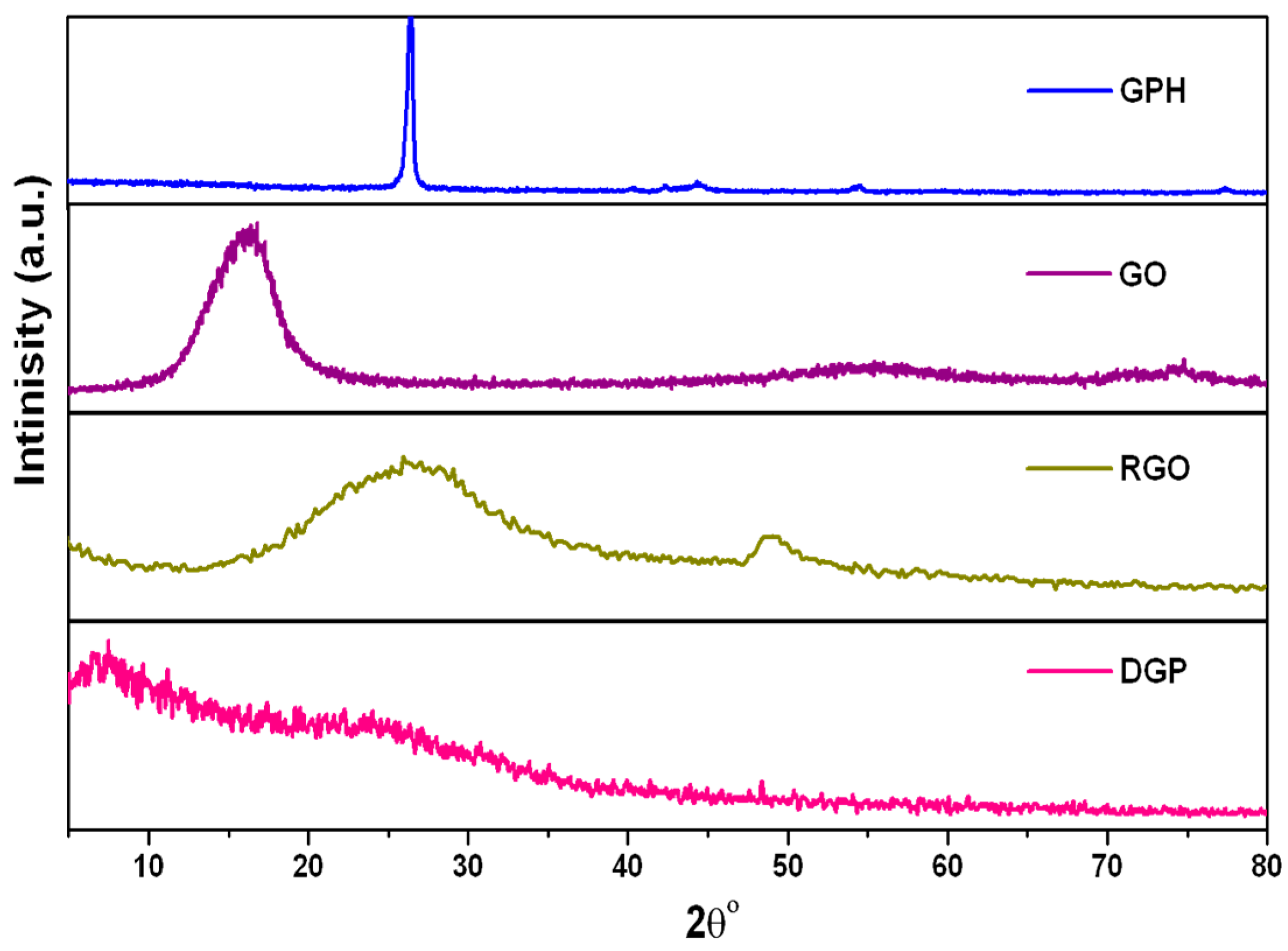
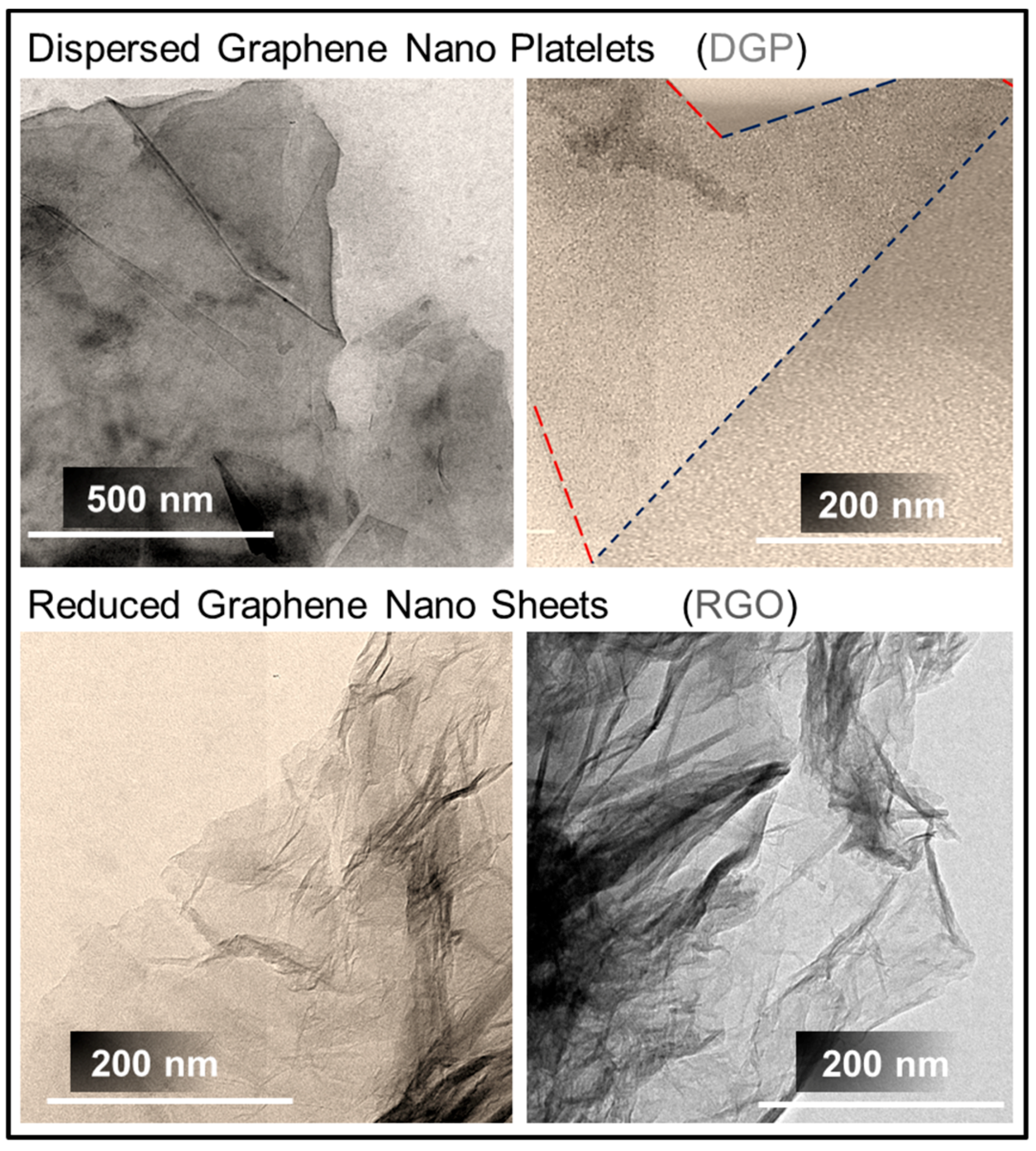
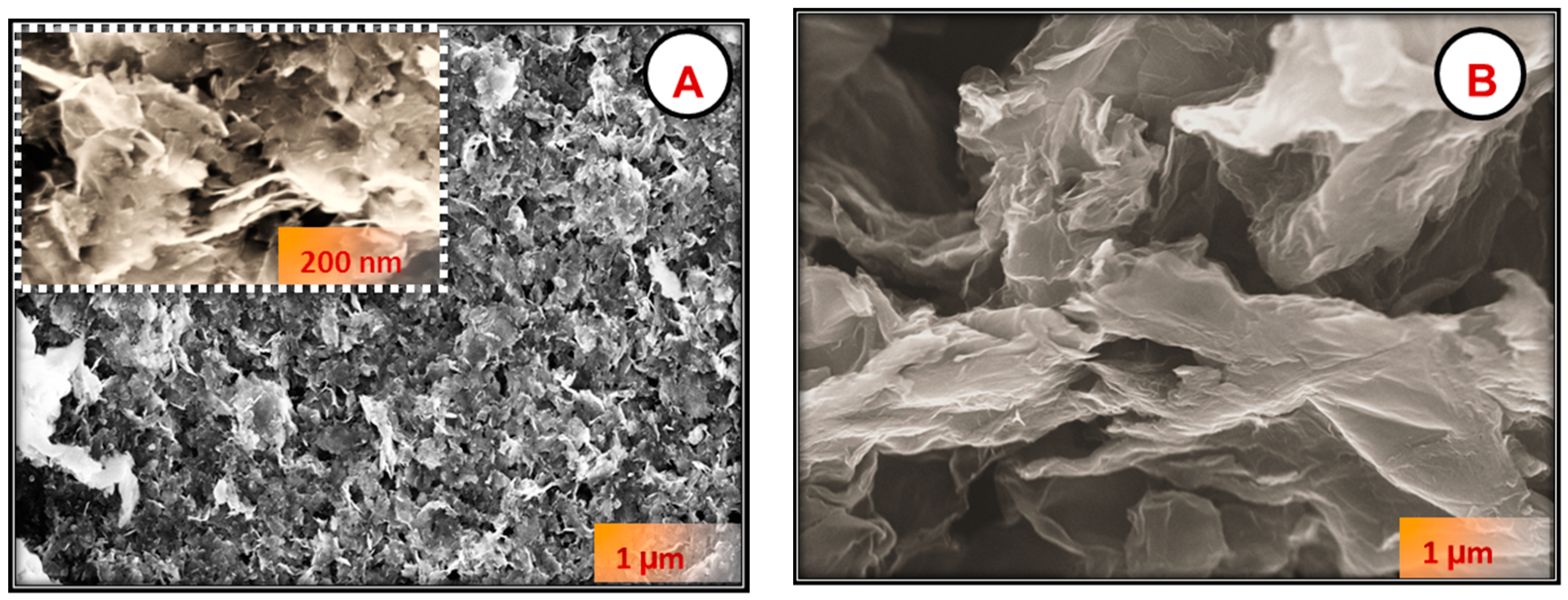
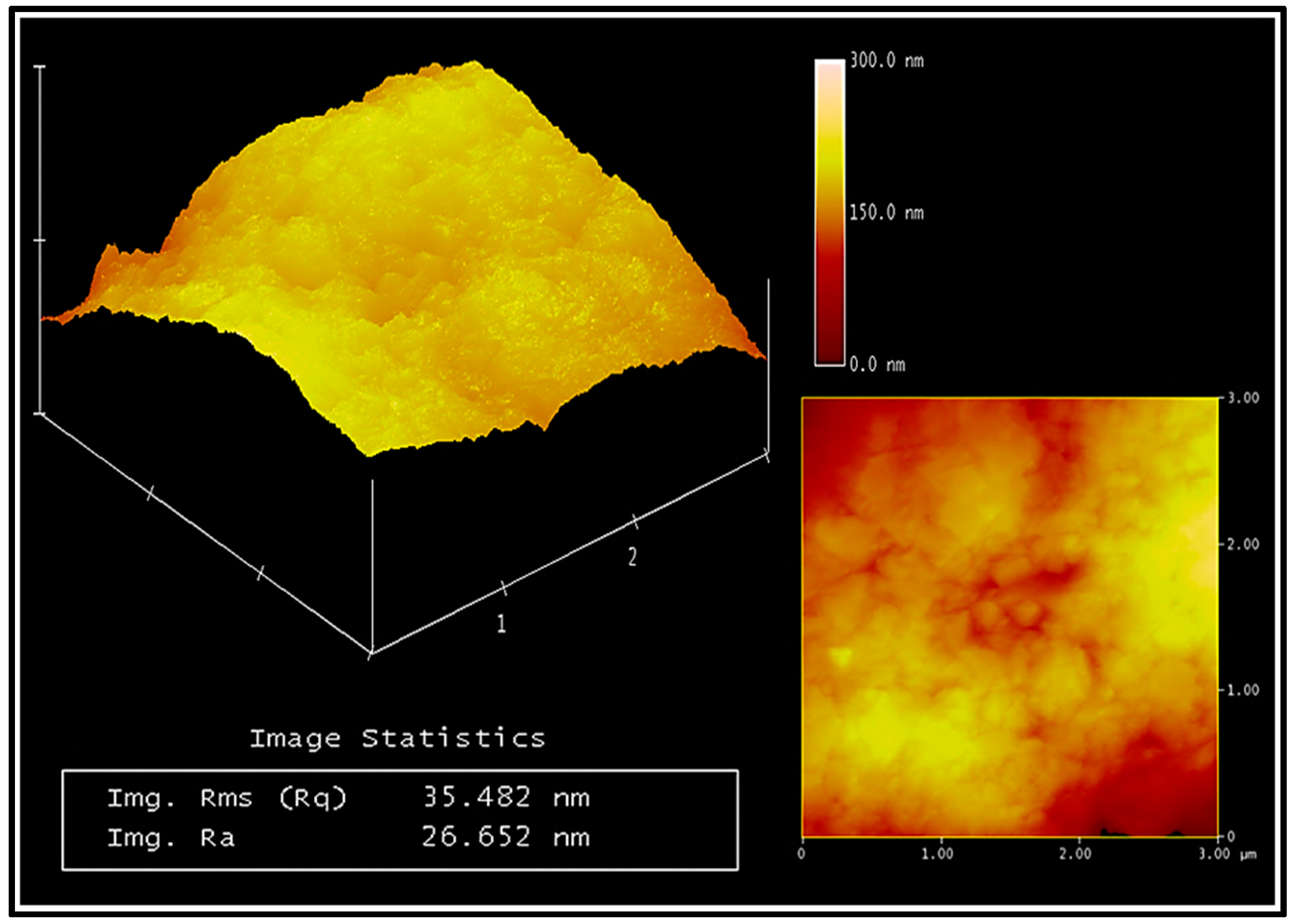
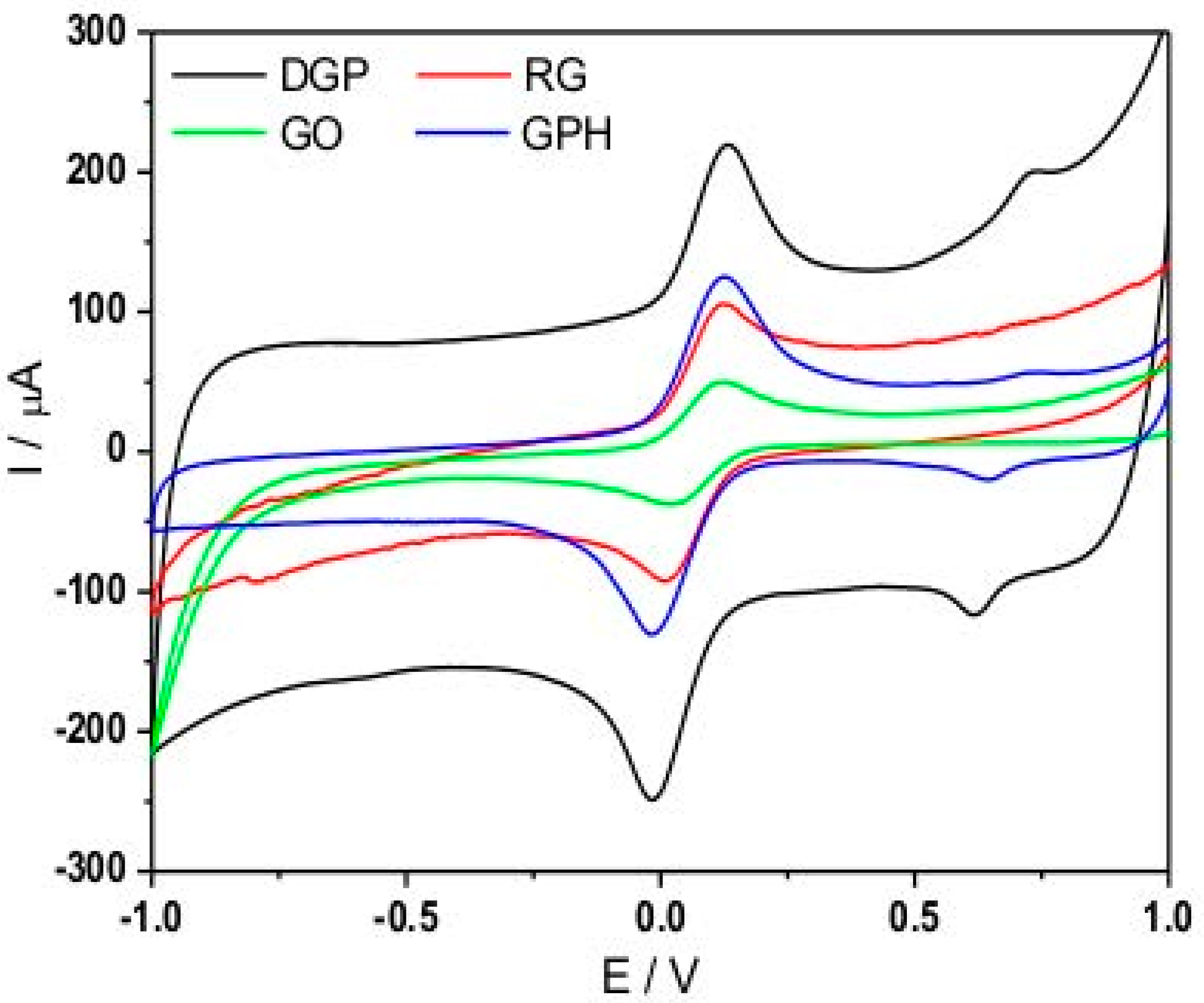
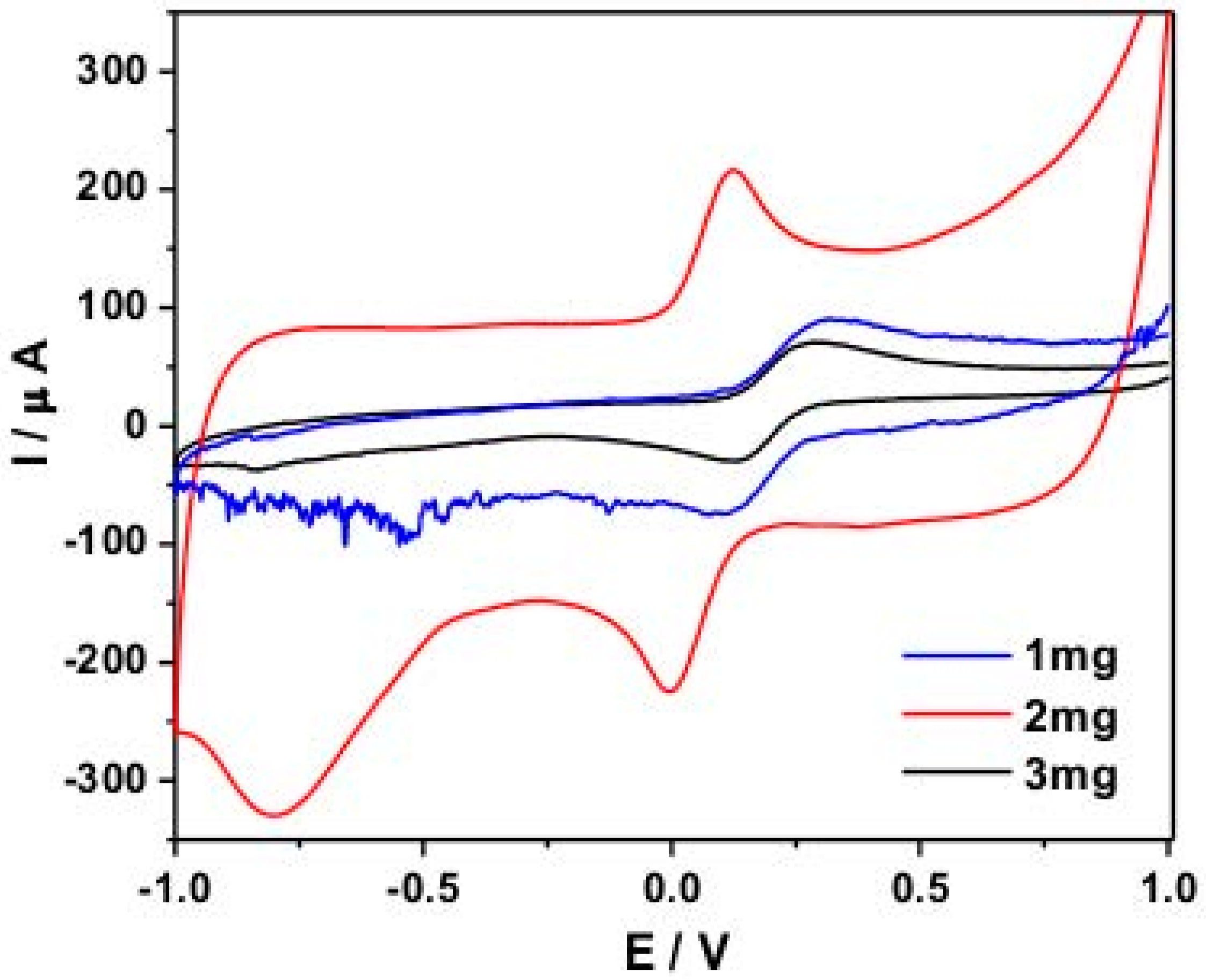
| Sample | N % | C % | S % | H % | O % |
|---|---|---|---|---|---|
| RGO | 2.159 | 64.59 | 2.2 | 6.4 | 24.6 |
| DGP | 0.876 | 89.99 | 0.335 | 1.2 | 7.6 |
| Analysis | DGP | RG | GO | GPH |
|---|---|---|---|---|
| Electrical Conductivity (S/cm) | 23.5 | 0.19 | 1.9 × 10−6 | 10 |
© 2018 by the author. Licensee MDPI, Basel, Switzerland. This article is an open access article distributed under the terms and conditions of the Creative Commons Attribution (CC BY) license (http://creativecommons.org/licenses/by/4.0/).
Share and Cite
Ghanem, A.F.; Abdel Rehim, M.H. Assisted Tip Sonication Approach for Graphene Synthesis in Aqueous Dispersion. Biomedicines 2018, 6, 63. https://doi.org/10.3390/biomedicines6020063
Ghanem AF, Abdel Rehim MH. Assisted Tip Sonication Approach for Graphene Synthesis in Aqueous Dispersion. Biomedicines. 2018; 6(2):63. https://doi.org/10.3390/biomedicines6020063
Chicago/Turabian StyleGhanem, Ahmed F., and Mona H. Abdel Rehim. 2018. "Assisted Tip Sonication Approach for Graphene Synthesis in Aqueous Dispersion" Biomedicines 6, no. 2: 63. https://doi.org/10.3390/biomedicines6020063
APA StyleGhanem, A. F., & Abdel Rehim, M. H. (2018). Assisted Tip Sonication Approach for Graphene Synthesis in Aqueous Dispersion. Biomedicines, 6(2), 63. https://doi.org/10.3390/biomedicines6020063





